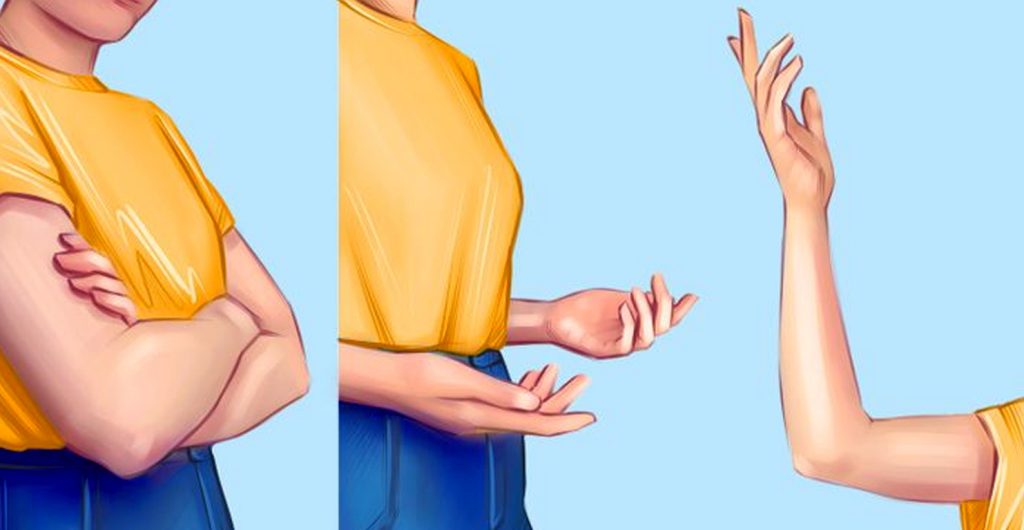
How to be more Likeable as a Tour Leader – 11 Habits of Likeable People
June 27, 2021
How to create shared value in tourism, one tour at a time
July 5, 2021If you ever look at video footage of some of the world’s most successful speakers, you’ll notice that they all have one thing in common: They use LOTS of hand gestures.
An fantastic study done by the Science of People reviewed thousands of hours of the most and least popular TED talks. The least popular speakers on TED used an average of 272 hand gestures over their 18 minute talk, while the most popular TED speakers used an average of 465 hand gestures—that’s almost double!
Other studies consistently show that if presenters use hand gestures, their audiences will remember up to twice as much information versus doing the same presentation without gestures. But this connection between memory and movement can also help you as the presenter.

Based on these results and the outcomes of earlier findings, Dr. Elena Nicoladis and her research colleagues at the University of Alberta believe there is a connection between language, memory access and gesturing. Nicoladis found that “the very fact of moving your hands helps you recall parts of the story – the gestures help you access memory and language…”
So if we appreciate that our hand gestures are actually an integral part of our tour – for both us and our audience – we should take some time to consider which movements are the most effective for speakers.
Have you ever wondered if there are hand gestures that you should avoid while speaking? There certainly are! That’s why we created a bonus PDF resource called, ‘Talking with Your Hands – 7 Common Mistakes to Avoid‘. Grab your free copy by clicking below and take a look at some of the gestures that may be holding you back.
What to do with your hands while speaking?
In this video, we’ll look at four types of effective hand gestures to put in your toolbox. There is a good chance that you are already using ‘the give’, ‘the mime’, ‘the show’ and ‘the chop’ – but we’ll look at how effectively speaking with our hands is all about choosing the right gesture for the right moment.
We’ll also find your base posture, which is the position that you should gesture to, and from when making hand movements. This will keep your motion natural looking and give you an idea of where to put your arms when not actively gesturing. I’ll also show you exactly where 90% of your hand movements should be to avoid distracting or confusing your audience
Enjoy the video, grab that PDF and start leveraging the power of effective hand gestures on your tours. Know someone who might appreciate these tips? Share this video and get them in on the action!
-Kelsey Tonner
Founder, Be a Better Guide
Finished Watching?
In the comments below, share any advice you have on gesturing more effectively while speaking. Any best practices you can share with the community? We’d love to hear from you!
Transcript
Well, if you sometimes feel like Ricky Bobby, then we’re here to help.
Hi. Kelsey Toner here from Be a Better Guide, and in this video we’re talking about hand and arm gestures.
Now, using these movements allow speakers to be more memorable, to communicate more effectively, and of course build a greater connection with your audience.
Studies consistently show that speakers that use hand gestures have their audiences remember up to twice as much of what they’re saying.
Another very interesting study done by the Science of People reviewed all of the most popular TED Talks and all of the least popular TED Talks.
And after reviewing thousands and thousands of hours of video footage, they found that the least popular TED Talks used an average of 272 hand gestures over the course of 18 minutes.
The most popular? Almost double: 465 hand gestures as an average, and this is from hundreds of different speakers and different topics. Coincidence?
We think not! So if you want to tap into the power of effective hand gestures as a tour guide, stay tuned.
Well, first and foremost we’ve got to find our base posture. Now, if you’re like Ricky Bobby off the top and you’re not quite sure what to do with your hands, you might be wondering, “Well, how can I do a hand gesture?
I don’t even know where I’m starting from,” so this exercise is for you. What I’d like you to do is look up into the sky, straight above you.
Raise your hands up and do a nice big stretch, reach as high as you can, and then let your arms fall just naturally. Now, look down at your hands, and this is your base posture.
While it may not feel the most comfortable, it actually is going to appear the most natural to your audiences, and oftentimes this is just naturally where our arms want to lay.
So when we’re thinking about hand gestures, we want to be starting from and then returning to this base posture.
Our second tip is to stay inside your box. You might be wondering, “Well, what box are you talking about?” Well we’re going to draw an imaginary box together.
It starts from about your shoulders and goes down to the bottom of your waist, just about belly button, and it extends out oh, just about to your wrists.
And so the vast majority of your gestures and hand movements should be within this imaginary box. If you review the most popular TED Talks of all time, most of their gestures are falling within this box.
If you go above it or in front of your face, or sometimes too low, this often comes across as out of control and just distracting.
Now, every rule can be broken, and sometimes we want to go outside of this box, maybe for exaggeration or if we want to use humor and be a little bit wild in emotions, like, “There was an explosion!” or something like this.
But just know, for the most part we want to be keeping our gestures inside of that box.
Now let’s look at four important types of gestures that every tour guide should have in their toolbox.
The first is the Give. It looks very much like this: “Your options for today’s lunch are the chicken or the beef.” As you can see, the motion is folding the hands, open like this, palm facing upward.
Now this is great, because it is offering information or offering choices. It can be used during a list that we want to tell them this, but then we’re also going to tell them this and tell them this.
As tour guides, we’re always communicating information and stories, interesting facts, and figures, so you’ll probably be using the Give quite a bit.
Another type of gesture you’ll want to use is called the Mime. Great story tellers will often act out the verbs that they’re using when telling their stories and in their sentences.
A simple example might be when Michael Angelo was carving the statue of the David.
Every day he went out and chipped and polished and chipped and polished and chipped and polished for a hundred days until it was perfect.
Or, after killing the king, the assassin ran along the ramparts of the castle and dove into the moat, never to be seen again.
So as you can see, we’re reinforcing our verbal communication with non-verbal communication.
Another type of gesture we’ll want to use is called the Show. This is a large category of gestures.
We’re essentially trying to visually represent the idea that we’re saying. A couple simple examples would be: ” just a little bit left.” We’ll often use that sign.
We might say there are four big choices we have to make in our life, or the president had two daughters. Any time we can represent a number with our hands or fingers we’ll often want to do that.
We might say something like, “There are three sizes – small, medium, and large,” or, “It was a big problem,” or, “I felt so sad.” We often touch this and we demonstrate that feeling or that sadness. So as you can see, we’re not acting out the verb so much as creatively representing what we’re saying.
One final type of gesture you’ll want to use is called the Chop. Now, this is used to deliver a strong message or add emphasis to certain parts of your story.
Basically it looks just like this: “The prince only had one thing that he needed to do.” You can chop with one hand; you can chop with two hands.
Sometimes when you’re telling multiple pieces of information we might say, “This was what happened in the 1800’s; this is what it was like mid-century; and then this is what happened at the turn of the millennium.”
Remember that the bigger the chop, the more emphasis you’re going to add. So we can say, “The mayor getting elected was the greatest thing that could’ve happened to this city,” and that’s going to add a lot of emphasis.
By practicing the techniques that we shared in this video, you’re going to be communicating more effectively, you’re going to be gesturing with purpose, and being more memorable for your audiences.
Now, some of you might be thinking, “Are there some hand gestures that I should avoid doing?”
You betcha! And that’s why we created an additional bonus PDF entitled Talking with your Hands: Seven Common Mistakes. You can get a copy of that PDF just below and see if there are any gestures that are holding you back.
But before you go, we’d love to hear from you. What advice do you have on using gestures while on tour? We’d love to hear from you.
Now, I would also love it if you took the time to share this video with somebody who you thought might appreciate it.
Thanks so much for being here, and I’ll see you next time.

